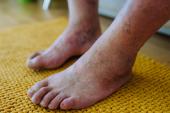FDA Approves Bioresorbable Scaffold for BTK Lesions
(UPDATED) The approval marks the return of the dissolving-scaffold concept, which so far has failed to find success in the coronaries.

The US Food and Drug Administration has approved an everolimus-eluting bioresorbable scaffold (Esprit BTK) for patients with below-the-knee (BTK) infrapopliteal disease, according to an announcement today from manufacturer Abbott.
The dissolving scaffold is the first dedicated device authorized by the FDA for the treatment of BTK lesions, with the approval based on results from the LIFE-BTK study. In 261 patients with chronic limb-threatening ischemia, the LIFE-BTK investigators showed that the scaffold reduced the risk of amputation, vessel occlusion, revascularization, and restenosis when compared with conventional angioplasty.
Sahil Parikh, MD (NewYork-Presbyterian/Columbia University Irving Medical Center, New York, NY), who led LIFE-BTK, said in a press release that the approval of the device “marks a significant milestone” in the treatment of patients with BTK peripheral artery disease. Operators frequently turn to drug-eluting stents for off-label use, as well as atherectomy/lithotripsy, drug-coated balloons (DCBs), and conventional angioplasty, because there have previously been no dedicated devices for the infrapopliteal territory.
“I view this as an important landmark in the field of peripheral intervention,” Parikh told TCTMD. “First, because we [now] have drug-eluting technology for below the knee—it is the first approved in the United States. Secondly, we came up with a clinical trial design that was not only successful but demonstrated clinical and biological efficacy. That's something that will be hopefully mimicked by other trials.”
The Esprit BTK device is completely dissolved in roughly 3 years, at which point the hope is the vessel is strong enough to stay open on its own, according to Abbott.
Difference vs Absorb in CAD
Esprit BTK’s approval marks a turning point in bioabsorbable technology. In the coronary arteries, the Absorb bioresorbable vascular scaffold (BVS), also from Abbott, never panned out. It was approved by the FDA in 2016 and gained CE Mark approval in Europe 5 years before that, but the emergence of scaffold thrombosis in various trials and meta-analyses sounded the technology’s death knell in the coronary space. It was eventually pulled from the US market in 2017 and is no longer commercially available anywhere.
Asked why he thinks Esprit BTK will be successful while Absorb BVS was not, Parikh said Absorb wasn’t entirely unsuccessful, but that it simply couldn’t outmatch contemporary stent technology. Moreover, the scaffold used in the ABSORB clinical trials of patients with coronary artery disease was analogous to a first-generation stent, such as Taxus and Cypher, with their thick struts.
“This is a much lower-profile device,” he said. “It has similar mechanical properties, similar drug-elution properties, but it’s more like a contemporary metallic drug-eluting stent.”
In addition, the resistance to thrombosis differs between the coronary and peripheral vasculature. While the reference diameters of infrapopliteal lesions are not too unlike the diameters of coronary arteries, the lesions are significantly longer.
Ramon Varcoe, MBBS, PhD (Prince of Wales Hospital/University of New South Wales, Randwick, Australia), who led LIFE-BTK alongside Parikh, said that chronic limb-threatening ischemia “is a very different disease” than ischemic heart disease, noting that the affected tibial arteries have very long, heavily calcified plaque that predominantly affects the medial layer.
“Our only approved tool currently is [plain balloon angioplasty],” he told TCTMD in an email. “Dedicated DES and DCB have not been shown to be effective. Therefore, the approval of Esprit BTK is a major leap forward for the field.”
Parikh said that operators have also learned a lot from the randomized trials in the coronary space, noting that they advocate for optimal implantation techniques when using the device. “We have made it a point that sizing must be done fastidiously and that postdilatation at high pressure is done in every case,” he said. Additionally, all patients are treated with dual antiplatelet therapy for 12 months.
The Life-BTK investigators plan to follow patients for at least 5 years and will publish more data as it becomes available.
Michael O’Riordan is the Managing Editor for TCTMD. He completed his undergraduate degrees at Queen’s University in Kingston, ON, and…
Read Full BioSources
Abbott. Abbott’s breakthrough dissolving stent receives FDA approval for arteries below the knee. Published and accessed on: April 29, 2024.





Comments